Report of Oversea Clerkship Program in Osaka City University
Clinical Training report
Ana Paula Kuwabara

- Country
- Brazil
- School
- University of Taubate
- Elective period
- 1 July 2019 to 12 July 2019
Introduction
My name is Ana Paula Kuwabara, a 5th year medical student in São Paulo, Brazil. I only spoke in English during the program even though I have Japanese ancestors and I have been to Japan before. It was my first time participating in an international exchange program and visiting a Japanese hospital and university. My first international exchange program being in Japan made it even more special and I would do it all over again!
Location
The dormitory is a 5 minutes by walk to the university and university hospital. OCU is right next to Tennoji temple and many department stores. I recommend you to try the various delicious Japanese food, especially being in “Japan’s kitchen”, the famous Osaka City.
Hospital
The OCU Hospital is impressively well-structured and organized. The doctors and students team were all very friendly to me, they would always ask if I had questions and if I understood the procedures and discussions. During every procedure, from the clinics to the surgeries, the doctors were respectful and caring towards the patients.
Japanese Culture & New Friends
The medical students from OCU were all so friendly to me. They were interested about medical studies and university life in Brazil and brazilian food. They taught me a lot of Japanese words and traditions. We all went to the Tennoji Temple Festival where I ate takoyaki (Japanese octopus snack), shaved ice and yakisoba. We wrote down our wishes and hang them on bamboo sticks. I also tried catching gold fishes, a very traditional summer festival activity.
Erika was the one who spoke the most English so we were able to deepen our friendship. She took me to Harukas 300, Japan’s tallest building. The view was amazing. We also went to a boat ride around Osaka city after a nice lunch by the river.
I miss Erika, Mari, Kenta, Akitsu and Hiroshi a lot already and I hope they come to visit me in Brazil! I will definitely go back to Japan so we can make new memories together!
Dermatology Department
Activities in which I participated: Outpatient clinic, inpatient visit, cases discussions, conference, surgery, lessons and patch test clinic.
On my first day, I was at the outpatient clinic, where I experienced a variety of cases that I had never seen before. After each patient, the doctor would explain in English or in Japanese the diagnostic hypothesis, the treatment conducted or about the pathogenesis of the disease. A 5th year medical student from OCU accompanied me to every activity and thanks to her, I was able to understand the lessons even though some of them were in Japanese. These are some diseases that I was able to experience and discuss during the outpatient clinic: liquen planus, tuberculosis, pityriasis rosea, impetigo, cellulitis, tinea pedis and many more.
The next day, we had a conference with all the dermatology team. They talked about different cases and at the same time showed the histopathology, which I thought was very enriching. Professor Tsuruta translated everything to me simultaneously, so I was able to take notes and also ask questions afterwards. After that, we had outpatient clinic and then a pathology class with the other OCU medical students. The professor taught us in English and Japanese and also asked us multiple questions, which made the class very interactive and I was able to recall a lot of information that we learn in the early years of medical school, but applied to the clinic.
During the elective, I was able to watch my first dermatology surgeries, in which they removed nevus that could be malignant. It was nice to see the surgical side of dermatology after learning a lot in the outpatient clinic.
We also learned how they apply the patch test on patients, how they analyse the results and what kind of substances are the most common.
During the inpatient visit, Professor Tsuruta asked the residents to explain all the cases in English so I was able to understand and learn a lot. The cases were more severe than those from the outpatient clinic, which included: Hodgkin lymphoma, linear IgA disease and herpes zoster.
The Dermatology Department was very welcoming and willing to explain, answer questions and get to know how the medical experience is like in Brazil. I will always remember with great joy my experience at Dermatology Department of Osaka City University Hospital.
Plastic and Reconstructive Surgery Department
Activities I participated in: lessons, suture practical class, inpatient visit, outpatient clinic, conference and surgery.
On my first day at the Plastic and Reconstructive Surgery Department, we had an “Introduction to Plastic and Reconstructive Surgery” class with Professor Motomura. One of the residents spoke English fluently and translated the entire lesson for me. We learned about the reconstructive surgery’s history in Italy and India and also about grafts and flaps.
Later that day, we participated in an infraorbital trauma surgery in which Professor Tsuruta took a piece from the iliac bone and placed it in the infraorbital bone. It was my first time watching the mold of a bone. I also learned why the iliac bone was chosen and also the differences uses between a bone and synthetic implants.
During the outpatient clinic, we would see the post operatory progression of the patients. They felt more confident after the reconstructive surgery. Some of the patients had a malignant tumor in the eye, so after the removal, a reconstructive surgery was conducted. Professor Motomura sketched how he developed a technique in which the patient’s eye contracture would be preserved, for example when they smiled. I was fascinated by the professor’s expertise so I read the published articles by the professor to learn more about this reconstruction. Additionally, the professor sent me his presentation about the technique, which I also studied and was even more impressed.
In the inpatient round, the doctors watched carefully the progression of wounds and post-surgery development. Then we went to the laser clinic where we were able to learn about the various diseases that can be treated with laser therapy and also about the different laser equipment used.
Later that day, there was a meeting to discuss patient’s cases and surgical plans and after that a company that sells surgery equipment. I was able to use the equipment on a model like in a surgery! It was fun! We also had a practical suture class which was held in a big laboratory. The equipment was very high quality and I was able to practice suture and also ask the residents about tips when suturing a patient.
The plastic surgery team also held a welcome party for me, in which we went to a traditional Japanese restaurant. I was able to try different Japanese shells, fish and soups for the first time, which were very yummy! It was an enjoyable time where we discussed the differences between medicine in Japan and in Brazil and about Japanese culture. Even though my ancestors are Japanese, I still learned a lot from them and I had a very nice time with them.
The second surgery I participated in was a cleft palate reconstruction. It was my first time watching this surgery, the surgeon was so talented because the surgery was in a baby, but still so accurate!
I would like to thank the Plastic and Reconstructive team for the opportunity to participate in their activities and also for all the lessons, attention and kindness.
Conclusion
My experience at OCU changed me as a person and as a medical student. I was able to learn about medical procedures, Japanese culture and meet amazing professionals. I’m thankful for the opportunity, consideration and attention from the OCU doctors, medical students and administrative staff. After this training, I became even more motivated to work hard in medicine and become an outstanding professional. Since my stay was very short, I definitely want to come back to OCU to learn even more! So I hope to see everyone soon! ;)


